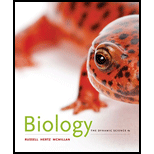
Biology: The Dynamic Science (MindTap Course List)
4th Edition
ISBN: 9781305389892
Author: Peter J. Russell, Paul E. Hertz, Beverly McMillan
Publisher: Cengage Learning
expand_more
expand_more
format_list_bulleted
Concept explainers
Question
Chapter 1.2, Problem 3SB
Summary Introduction
To review:
The usefulness of being camouflaged in natural environments.
Introduction:
Mutations can be defined as the random changes in the DNA (deoxyribonucleic acids), which are heritable in nature. Some mutations are favorable and these favorable mutations are able to produce adaptations. The adaptations can be defined as the characteristics, which help in longer survival and production of more offspring in a certain environmental condition.
Expert Solution & Answer
Trending nowThis is a popular solution!

Students have asked these similar questions
What is the structure and function of Eukaryotic cells, including their organelles? How are Eukaryotic cells different than Prokaryotic cells, in terms of evolution which form of the cell might have came first? How do Eukaryotic cells become malignant (cancerous)?
What are the roles of DNA and proteins inside of the cell? What are the building blocks or molecular components of the DNA and proteins? How are proteins produced within the cell? What connection is there between DNA, proteins, and the cell cycle? What is the relationship between DNA, proteins, and Cancer?
Why cells go through various types of cell division and how eukaryotic cells control cell growth through the cell cycle control system?
Chapter 1 Solutions
Biology: The Dynamic Science (MindTap Course List)
Ch. 1.1 - Prob. 1SBCh. 1.1 - What do living organisms do with the energy they...Ch. 1.1 - What is a life cycle?Ch. 1.2 - What is the difference between artificial...Ch. 1.2 - How do random changes in the structure of DNA...Ch. 1.2 - Prob. 3SBCh. 1.3 - What is a major difference between prokaryotic and...Ch. 1.3 - Prob. 2SBCh. 1.3 - Prob. 3SBCh. 1.4 - In your own words, explain the most important...
Ch. 1.4 - What information did the copper lizard models...Ch. 1.4 - Prob. 3SBCh. 1 - What is the lowest level of biological...Ch. 1 - Which category falls immediately below class in...Ch. 1 - Houseflies develop through a series of programmed...Ch. 1 - Which structure allows living organisms to detect...Ch. 1 - Prob. 5TYKCh. 1 - Prob. 6TYKCh. 1 - Which of the following represents the application...Ch. 1 - Which of the following is not a component of...Ch. 1 - Which of the following questions best exemplifies...Ch. 1 - When researchers say that a scientific hypothesis...Ch. 1 - Prob. 11TYKCh. 1 - What role did the copper lizard models play in the...Ch. 1 - Prob. 13TYKCh. 1 - Prob. 14TYKCh. 1 - Apply Evolutionary Thinking When a biologist first...Ch. 1 - Prob. 1ITD
Knowledge Booster
Learn more about
Need a deep-dive on the concept behind this application? Look no further. Learn more about this topic, biology and related others by exploring similar questions and additional content below.Similar questions
- In one paragraph show how atoms and they're structure are related to the structure of dna and proteins. Talk about what atoms are. what they're made of, why chemical bonding is important to DNA?arrow_forwardWhat are the structure and properties of atoms and chemical bonds (especially how they relate to DNA and proteins).arrow_forwardThe Sentinel Cell: Nature’s Answer to Cancer?arrow_forward
- Molecular Biology Question You are working to characterize a novel protein in mice. Analysis shows that high levels of the primary transcript that codes for this protein are found in tissue from the brain, muscle, liver, and pancreas. However, an antibody that recognizes the C-terminal portion of the protein indicates that the protein is present in brain, muscle, and liver, but not in the pancreas. What is the most likely explanation for this result?arrow_forwardMolecular Biology Explain/discuss how “slow stop” and “quick/fast stop” mutants wereused to identify different protein involved in DNA replication in E. coli.arrow_forwardMolecular Biology Question A gene that codes for a protein was removed from a eukaryotic cell and inserted into a prokaryotic cell. Although the gene was successfully transcribed and translated, it produced a different protein than it produced in the eukaryotic cell. What is the most likely explanation?arrow_forward
- Molecular Biology LIST three characteristics of origins of replicationarrow_forwardMolecular Biology Question Please help. Thank you For E coli DNA polymerase III, give the structure and function of the b-clamp sub-complex. Describe how the structure of this sub-complex is important for it’s function.arrow_forwardMolecular Biology LIST three characteristics of DNA Polymerasesarrow_forward
arrow_back_ios
SEE MORE QUESTIONS
arrow_forward_ios
Recommended textbooks for you
 Principles Of Radiographic Imaging: An Art And A ...Health & NutritionISBN:9781337711067Author:Richard R. Carlton, Arlene M. Adler, Vesna BalacPublisher:Cengage Learning
Principles Of Radiographic Imaging: An Art And A ...Health & NutritionISBN:9781337711067Author:Richard R. Carlton, Arlene M. Adler, Vesna BalacPublisher:Cengage Learning- Lifetime Physical Fitness & WellnessHealth & NutritionISBN:9781337677509Author:HOEGERPublisher:Cengage
 Human Biology (MindTap Course List)BiologyISBN:9781305112100Author:Cecie Starr, Beverly McMillanPublisher:Cengage Learning
Human Biology (MindTap Course List)BiologyISBN:9781305112100Author:Cecie Starr, Beverly McMillanPublisher:Cengage Learning

Principles Of Radiographic Imaging: An Art And A ...
Health & Nutrition
ISBN:9781337711067
Author:Richard R. Carlton, Arlene M. Adler, Vesna Balac
Publisher:Cengage Learning



Lifetime Physical Fitness & Wellness
Health & Nutrition
ISBN:9781337677509
Author:HOEGER
Publisher:Cengage

Human Biology (MindTap Course List)
Biology
ISBN:9781305112100
Author:Cecie Starr, Beverly McMillan
Publisher:Cengage Learning
